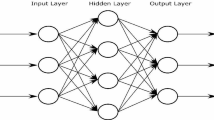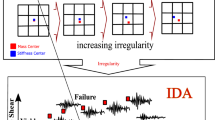Abstract
The squat reinforced concrete (RC) shear wall having low aspect ratio is a crucial structural component for both conventional buildings and nuclear-related structures due to the substantial role in resisting the lateral seismic loading. The prediction model for shear capacity of these walls becomes essential in ensuring the seismic safety of the building. Therefore, a model to predict the shear strength of squat RC walls has been proposed using a hybrid intelligence algorithm including the artificial neural network and particle swarm optimization algorithm (ANN–PSO). A total of 139 test results of squat walls are collected and utilized to train and test the hybrid ANN–PSO model. The performance of the proposed model has been assessed against the other shear strength models. The proposed model demonstrates good prediction capability with high accuracy for predicting shear strength of the RC walls.











Similar content being viewed by others
Abbreviations
- h :
-
Thickness of the shear wall
- d :
-
Effective depth of the cross section
- S :
-
Spacing of the horizontal reinforcement bar
- A cw :
-
Area of the wall bounded by the web thickness and wall length
- b w :
-
Minimum width of the web in the tension area
- A SW :
-
Cross-sectional area of shear reinforcement within S
- z :
-
Lever of internal forces (z ≈ 0.9d)
- A w :
-
Area of the web cross section
- A :
-
Gross area of the cross section
- A v :
-
Area of shear reinforcement within spacing S
- A sh :
-
Total area of horizontal reinforcement
- A vf :
-
Total area of vertical reinforcement in the wall
- A cv :
-
Effective cross-sectional area of the concrete section
- l w :
-
Length of the wall
- f yt :
-
Yield strength of transverse reinforcement
- f ywd :
-
Yield strength of shear reinforcement
- \({f_{{\text{yv}}}}\) :
-
Yield strength of vertical reinforcement
- \({f^{\prime}_{\text{c}}}\) :
-
Compressive strength of the cylinder concrete
- \({f_{\text{t}}}\) :
-
Tension strength of the prism concrete (\({f_{\text{t}}} \approx 0.1{f_{\text{c}}}\))
- \({f_{\text{c}}}\) :
-
Compressive strength of the prism concrete (\({f_{\text{c}}} \approx 0.838{f^{\prime}_{\text{c}}}\))
- \({f_{{\text{ck}}}}\) :
-
Characteristic compressive cylinder strength of concrete at 28 days
- \({N_{\text{u}}}\) :
-
Axial load
- \({\sigma _{{\text{cp}}}}\) :
-
Axial compress stress
- \({M_{\text{u}}}\) :
-
Moment at section
- \({V_{\text{u}}}\) :
-
Shear force at section
- \({\alpha _{\text{c}}}\) :
-
Aspect ratio coefficient. \({\alpha _{\text{c}}}\) equals 0.17 for an aspect ratio ≥ 2.0; 0.25 for the aspect ratio ≤ 1.5, and varies linearly within 1.5 ≤ λ ≤ 2.2
- \({\rho _{\text{v}}}\) :
-
Vertical reinforcement ratio
- \({\rho _{\text{t}}}\) :
-
Horizontal reinforcement ratio
- \({C_{{\text{Rd}},{\text{c}}}}\) :
-
\(0.18/{\gamma _{\text{c}}}\)
- \({\gamma _{\text{c}}}\) :
-
Concrete partial coefficients, equal to 0.15
- k :
-
\(1+\sqrt {\frac{{200}}{d}} \leq 2.0\)
- \({k_1}\) :
-
A coefficient considering the effects of axial load forces on the stress distribution, equal to 0.15
- \({\phi _{\text{c}}}\) :
-
Resistance factor of the concrete, equal to 0.65
- \({\phi _{\text{s}}}\) :
-
Resistance factor for non-prestressed reinforcing bars, equal to 0.18
- \(\alpha\) :
-
Angle between the concrete compression strut and the wall axis perpendicular to the shear force. The recommended limits of \(\cot \alpha\) is from 1 to 2.5. In this paper, the value of \(\cot \alpha\) is assumed equal to 1
- \(\theta\) :
-
Angle between the concrete compression strut and the wall axis perpendicular to the shear force. It equals 45° for the axial load ratio \(\leq 0.1;\) 35° for the axial load ratio \(\geq 0.2,\) and varies linearly for the axial load ratio between 0.1 and 0.2
- \(\beta\) :
-
Factor accounting for the shear resistance of cracked concrete, chosen as 0.18
- \(\lambda\) :
-
Aspect ratio coefficient which equal 1.5 for \(\lambda \leq 1.5,\) 2.2 for \(\lambda \geq 2.2,\) and varies linearly for \(1.5 \leq \lambda \leq 2.2\)
- \(\lambda ^{\prime}\) :
-
Modification factor to reflect the reduced mechanical properties of lightweight concrete relative to normal weight concrete of the same compressive strength. It equals 1.0 in the paper
- \({\gamma _{{\text{RE}}}}\) :
-
The seismic action coefficient, which is equal to 0.85
References
Gulec CK, Whittaker AS, Stojadinovic B (2008) Shear strength of squat rectangular reinforced concrete walls. ACI Struct J 105(4):488
Ministry of Housing and Urban-Rural Development of the People’s Republic of China (2010) Code for design of concrete structures (GB50010-2010). Ministry of Housing and Urban-Rural Development of the People’s Republic of China, Beijing (in Chinese)
American Concrete Institute (2014) Building code requirement for reinforced concrete (ACI 318-14). American Concrete Institute, Farmington Hills
European Committee for Standardization (2004) Design of structures for earthquake resistance-part 1: general rules, seismic actions and rules for buildings (Eurocode 8). European Committee for Standardization, Brussels
Canadian Standards Association (2004) Design of concrete structures (CSA A23.3-04). Canadian Standards Association, Mississauga
Wood SL (1990) Shear strength of low-rise reinforced concrete walls. Struct J 87(1):99–107
Gulec CK, Whittaker AS, Stojadinovic B (2007) Shear strength of squat reinforced concrete walls with flanges and barbells. In: Proceedings of the 19th international conference on structural mechanics in reactor technology. Tronto, pp 1–8
Schlaich J, Schäfer K, Jennewein M (1987) Toward a consistent design of structural concrete. PCI J 32(3):74–150
Chithra S, Kumar SS, Chinnaraju K, Ashmita FA (2016) A comparative study on the compressive strength prediction models for High Performance Concrete containing nano silica and copper slag using regression analysis and Artificial Neural Networks. Constr Build Mater 114:528–535
Kişi Ö (2007) Streamflow forecasting using different artificial neural network algorithms. J Hydrol Eng 12(5):532–539
Gao W, Chen D, Dai S, Wang X (2017) Back analysis for mechanical parameters of surrounding rock for underground roadways based on new neural network. Eng Comput (5):1–12
Khademi F, Jamal SM, Deshpande N, Londhe S (2016) Predicting strength of recycled aggregate concrete using Artificial Neural Network, Adaptive Neuro-Fuzzy Inference System and Multiple Linear Regression. Int J Sustain Built Environ 5(2):355–369
Gordan B, Armaghani DJ, Hajihassani M, Monjezi M (2016) Prediction of seismic slope stability through combination of particle swarm optimization and neural network. Eng Comput 32(1):85–97
Wang S (2015) Optimized BP neural network and its using in the heat exchange station. Master’s thesis, Xi’an University of Architecture and Technology, China (in Chinese)
Kirkpatrick S, Gelatt CD, Vecchi MP (1983) Optimization by simulated annealing. Science 220(4598):671–680
Indurkhya N, Weiss SM (1992) Heuristic configuration of single hidden-layer feed-forward neural networks. Appl Intell 2(4):325–331
Dehuri S, Cho SB (2010) A comprehensive survey on functional link neural networks and an adaptive PSO-BP learning for CFLNN. Neural Comput Appl 19(2):187–205
Kennedy J, Eberhart R (1995) Particle swarm optimization. In: Proceedings of IEEE international conference on neural networks, Piscataway, pp 1942–1948
Mohamad ET, Armaghani DJ, Momeni E, Abad SVANK. (2015) Prediction of the unconfined compressive strength of soft rocks: a PSO-based ANN approach. Bull Eng Geol Environ 74(3):745–757
Hasanipanah M, Noorian-Bidgoli M, Armaghani DJ, Khamesi H (2016) Feasibility of PSO–ANN model for predicting surface settlement caused by tunneling. Eng Comput 32(4):705–715
Engelbrecht AP (2008) Computational intelligence: an introduction. IEEE Trans Neural Netw 16(3):780–781
Wang L (2010) Experimental and analysis research on low reinforcement shear wall without opening at six degree zone. Master’s thesis, Chongqing University, China (in Chinese)
Mingke LXXLD., Xinghu FLZ (2010) Experimental study on seismic behavior and performance indexes of high-strength concrete shear walls. China Civ Eng J 43(11):37–45 (in Chinese)
Li H, Li B (2004) Experimental study on seismic restoring performance of reinforced concrete shear walls. J Build Struct 25(5):35–42 (in Chinese)
Zhang Y, Zhang L, Yan S (2010) Seismic experiments for high strength concrete shear walls reinforced with high strength rebars. J Shenyang Jianzhu Univ (Nat Sci) 26(01):119–123 (in Chinese)
Kong H (2010) Experimental research on influence of the structural behaviors of the RC-shear walls with different reinforcement ratio. Master’s thesis, China Academy of Building Research, China (in Chinese)
Li X (2009) Direct displacement-based seismic design method of high performance concrete shear walls. Doctor’s thesis, Xi’an University of Architecture and Technology, China (in Chinese)
Hidalgo PA, Ledezma CA, Jordan RM (2002) Seismic behavior of squat reinforced concrete shear walls. Earthq Spectra 18(2):287–308
Lopes MS (2001) Experimental shear-dominated response of RC walls: part I: objectives, methodology and results. Eng Struct 23(3):229–239
Lefas ID, Kotsovos MD, Ambraseys NN (1990) Behavior of reinforced concrete structural walls: strength, deformation characteristics, and failure mechanism. Struct J 87(1):23–31
Mickleborough NC, Ning F, Chan CM (1999) Prediction of the stiffness of reinforced concrete shear walls under service loads. ACI Struct J 96(6):1018–1026
Salonikios TN, Kappos AJ, Tegos IA, Penelis GG (2000) Cyclic load behavior of low-slenderness reinforced concrete walls: failure modes, strength and deformation analysis, and design implications. ACI Struct J 97(1):132–141
Pilakoutas K (1990) Earthquake resistant design of reinforced concrete walls, vol 1. Imperial College London, London, pp 2289–4454
Gulec CK, Whittaker AS (2009) Performance-based assessment and design of squat reinforced concrete shear walls. Dissertations and Theses-Gradworks
Synge AJ (1980) Ductility of squat shear walls. PhD thesis, University of Canterbury, New Zealand
Greifenhagen C, Papas D, Lestuzzi P (2005) Static-cyclic tests on reinforced concrete shear walls with low reinforcement ratios. Gen Inf 1–113
Mast RF (1968) Auxiliary reinforcement in concrete connections. J Struct Div 94(06):1485–1504
Cao WL, Liu Q, Zhang JW, Zhang YQ, Yin HP (2011) Research on seismic performance of low-rise recycled concrete shear walls. J Beijing Univ Technol 37(03):409–417
Jun JH, Lin LX (1997) The experimental study on the squat vertical energy dissipation walls under cyclic loading. Eng Mech (a02):649–654 (in Chinese)
Wang L, Li F, Zhu W, Wang G, Li H, Xiao S (2007) Experimental study on seismic behavior of shear wall with concealed bracings. J Build Struct 28(S1):51–58
Quiroz LG, Maruyama Y, Zavala C (2013) Cyclic behavior of thin RC Peruvian shear walls: full-scale experimental investigation and numerical simulation. Eng Struct 52:153–167
Athanasopoulou A, Parra-Montesinos G (2013) Experimental study on the seismic behavior of high-performance fiber-reinforced concrete low-rise walls. ACI Struct J 110(5):767–777
Gulec CK (2009) Performance-based assessment and design of squat reinforced concrete shear walls. State University of New York at Buffalo, Buffalo
Baheer I (2000) Selection of methodology for modeling hysteresis behavior of soils using neural networks. J Comput Aided Civil Infrastruct Eng 5(6):445–463
Paola JD (1994) Neural network classification of multispectral imagery. Master Thesis, The University of Arizona, USA
Masters T (1993) Practical neural network recipes in C++. In: Shapiro AF, Defilippo TA, Phinney KJ, Zhang J (eds), vol 9(4), p 313
Kaastra I, Boyd M (1996) Designing a neural network for forecasting financial and economic time series. Neurocomputing 10(3):215–236
Hecht-Nielsen R (1987) Kolmogorov’s mapping neural network existence theorem. In: Proceedings of the international conference on Neural Networks. IEEE, New York, pp. 11–13
Hagan MT, Menhaj MB (1994) Training feedforward networks with the Marquardt algorithm. IEEE Trans Neural Netw 5(6):989–993
Mendes R, Cortez P, Rocha M, Neves J (2002) Particle swarms for feedforward neural network training. In: Proceedings of the 2002 international joint conference on neural networks. IEEE, New York, pp. 1895–1899
Clerc M, Kennedy J (2002) The particle swarm-explosion, stability, and convergence in a multidimensional complex space. IEEE Trans Evol Comput 6(1):58–73
Kalatehjari R, Ali N, Kholghifard M, Hajihassani M (2014) The effects of method of generating circular slip surfaces on determining the critical slip surface by particle swarm optimization. Arab J Geosci 7(4):1529–1539
Acknowledgements
The research for this paper was supported by the National Science Foundation of China under Grant no. 51478063.
Author information
Authors and Affiliations
Corresponding author
Rights and permissions
About this article
Cite this article
Chen, X.L., Fu, J.P., Yao, J.L. et al. Prediction of shear strength for squat RC walls using a hybrid ANN–PSO model. Engineering with Computers 34, 367–383 (2018). https://doi.org/10.1007/s00366-017-0547-5
Received:
Accepted:
Published:
Issue Date:
DOI: https://doi.org/10.1007/s00366-017-0547-5




